Exploring the Al Suwaidi Building: A Dubai Icon
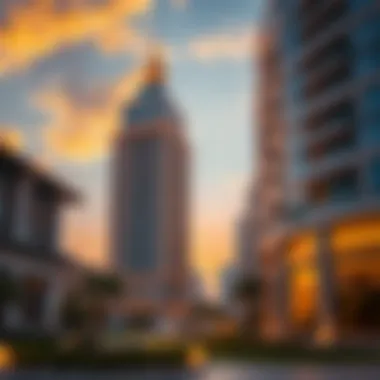
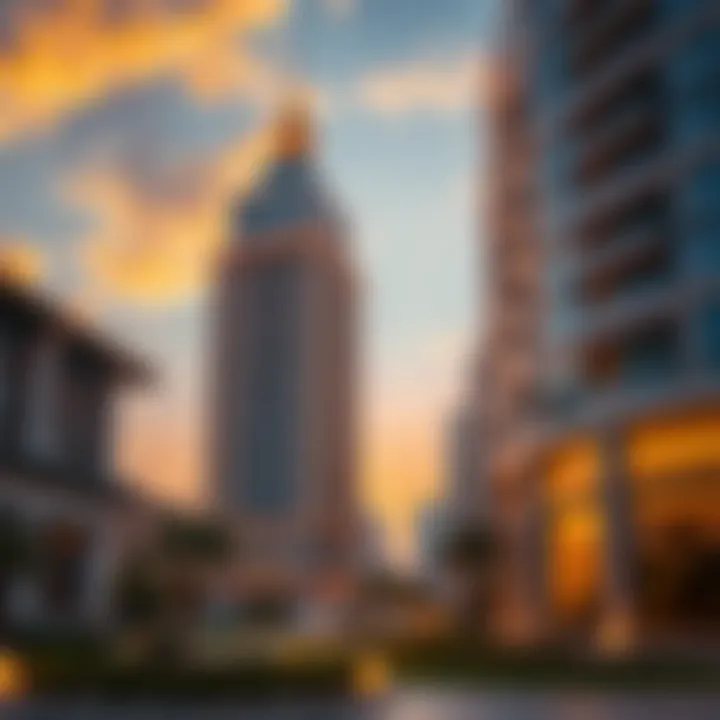
Intro
The allure of Dubai's skyline is undeniably captivating, and among its architectural marvels stands the Al Suwaidi Building. This striking structure is more than just a piece of real estate; it embodies the rapid evolution of Dubai's urban landscape and its cultural dynamism. The blend of contemporary design with functional elegance sets it apart, making it a focal point in conversations about the future of luxury living in this thriving city.
In this exploration, we aim to unravel the intricacies of the Al Suwaidi Building, from its imaginative architectural features to its vital role in the community. For potential investors, homeowners, and architecture enthusiasts, understanding this building’s significance provides a lens through which to view the broader real estate trends shaping Dubai today.
Market Insights
Current Trends in Dubai Real Estate
Dubai's real estate market is currently experiencing a vibrant shift. The demand for luxury properties has surged, influenced by both local and international factors. Investors looking for high returns have shown a keen interest in iconic buildings like the Al Suwaidi Building.
Several key trends are observable in the market today:
- Sustained Growth: Despite fluctuations, the demand for high-end properties has remained relatively stable. This has resulted in a noticeable increase in property values across central locations, including those surrounding the Al Suwaidi Building.
- Diversification Strategies: Investors are increasingly diversifying their portfolios with both commercial and residential properties, encouraging mixed-use developments which have benefits similar to those offered by the Al Suwaidi Building.
- Sustainability Initiatives: More developers are prioritizing eco-friendly designs, improving energy efficiency, and utilizing sustainable materials — the principles that are reflected in the architecture of the Al Suwaidi Building.
Investment Opportunities in Key Areas
The area around the Al Suwaidi Building presents several viable investment opportunities:
- Residential Units: The luxury apartments within the building have attracted a considerable amount of interest from expatriates as well as local buyers. The blend of modern amenities and strategic location contributes to their allure.
- Commercial Ventures: With the rise of small businesses and startups in Dubai, properties that offer mixed-use spaces, such as retail and office locations, are in demand. The ground floors of buildings like the Al Suwaidi offer an excellent opportunity for shops and cafes.
- Cultural Development: The growing focus on cultural experiences in Dubai creates a nurturing environment for community projects. Collaborations between investors and local cultural groups can yield fruitful outcomes.
As the market evolves, insights into these trends will help individuals make informed decisions, particularly those looking to invest in the luxurious spaces that the Al Suwaidi Building epitomizes.
Lifestyle Features
Luxury Living and Amenities
Stepping into the Al Suwaidi Building, one encounters a meticulously crafted façade that reflects both modern sophistication and comfort. The luxury living it offers is complemented by an array of top-tier amenities that cater to the needs of discerning residents.
Facilities include:
- State-of-the-art fitness centers
- Infinity pools with stunning city views
- 24-hour concierge services which ensure a seamless living experience
- Elegant communal spaces for networking and socializing
These features cultivate a sense of community among residents, reinforcing the notion that living in a luxurious environment does not mean sacrificing connection.
Cultural Attractions and Experiences
The charm of the Al Suwaidi Building extends beyond its walls, as it is ideally positioned within a vibrant neighborhood rich with cultural attractions. Residents and visitors can immerse themselves in:
- The bustling art galleries showcasing local talent and international exhibitions.
- Heritage sites that narrate the rich history of Dubai, allowing newcomers and locals alike to appreciate the city's journey.
- Culinary experiences ranging from traditional Emirati dishes to fine dining establishments helmed by world-renowned chefs.
The proximity to such cultural experiences serves not only to enhance the lifestyle of residents but also attracts tourists, creating a melding of interests that supports the local economy.
"Investing in properties like the Al Suwaidi Building is more than financial; it's about becoming part of a thriving cultural ecosystem".
As we forge ahead into this analysis, a deeper understanding of the Al Suwaidi Building's implications in the luxury market and its community-driven architecture will emerge, allowing for a comprehensive narrative that resonates with stakeholders in Dubai’s real estate landscape.
Foreword to the Al Suwaidi Building
The Al Suwaidi Building stands as a beacon of architectural innovation within the bustling fabric of Dubai, a city celebrated for its audacious structures and stunning skyline. Understanding the nuances of this building is essential, not merely to appreciate its aesthetic beauty but also to grasp its significance in the realm of real estate and community development in the region.
This introduction serves as a launchpad into the depths of what makes the Al Suwaidi Building a standout structure. It sets the stage for exploring historical context, its economic impact, and its role in shaping Dubai's unique architectural landscape. For anyone involved in the intricate dance of property investment, homebuying, or even urban planning, comprehending the story behind this landmark is invaluable.
Historical Background
The roots of the Al Suwaidi Building stretch back to the early 21st century, coinciding with Dubai's rapid economic growth and urban sprawl. Construction commenced during a period of burgeoning property demand, influenced by foreign investments and luxury real estate trends. The architects, drawing from both local culture and modernist principles, sought to create a structure that not only filled the pressing need for commercial space but also added to the visual allure of Dubai's skyline.
Owing to its strategic location in the heart of the city, the building has become a pivotal landmark in not just the architectural narrative but also in the socio-economic landscape of Dubai. Its completion marked a turning point, symbolizing the commitment to innovation that has defined Dubai's real estate ever since.
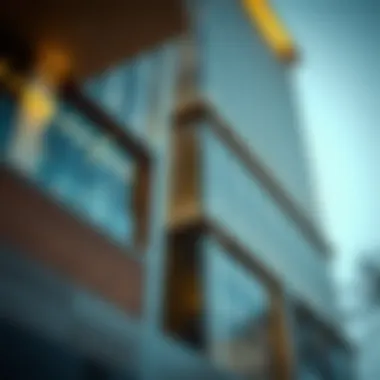
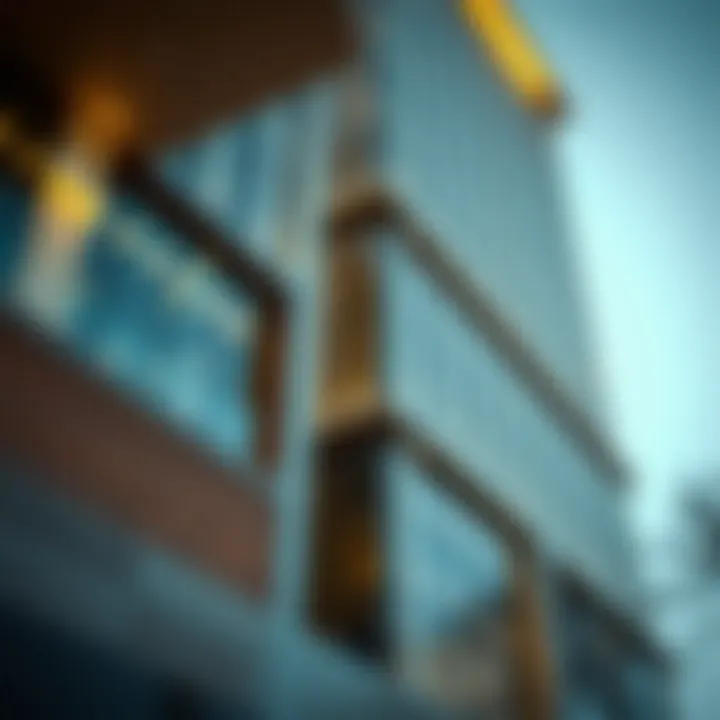
Significance in Dubai's Real Estate Market
The Al Suwaidi Building has carved out a niche within Dubai's competitive real estate sector. Its architectural flair and premium amenities render it attractive to business tenants and potential investors alike. The soaring rent prices for commercial spaces have positioned the building as a lucrative investment opportunity in the luxury market.
Consider factors such as:
- Rental yields: The figures reflect healthy returns, attracting investors looking to capitalize on Dubai's booming economy.
- Market demand: Its strategic location fuels significant interest from both local and international businesses, enhancing its desirability.
A notable highlight includes the building's reputation for drawing high-profile tenants, which in turn increases foot traffic and adds to the vibrancy of the adjacent developments. This synergy between architecture, market demand, and community has made the Al Suwaidi Building a linchpin in Dubai's ongoing evolution as a global business hub.
"As Dubai continues to invest in its infrastructure and urban planning, the Al Suwaidi Building serves not merely as a structure but as a statement of intent for the future. Its significance transcends bricks and mortar; it is a part of a larger vision for a cosmopolitan city that embraces progress."
Delving into the Al Suwaidi Building’s narrative reinforces its role as more than just a physical space—it encapsulates aspirations of economic growth, cultural identity, and community engagement that resonate with investors and residents alike.
Architectural Design
Architectural design serves as a vital element in any discussion surrounding iconic buildings, especially in a bustling metropolis like Dubai. The Al Suwaidi Building stands out as a prime example of how architecture can reflect cultural values, economic aspirations, and environmental considerations. The thoughtful integration of design principles not only enhances the building's functional appeal but also elevates its aesthetic value, weaving it seamlessly into Dubai's architectural landscape.
Given the rapid urbanization in the region and the unique challenges that come with it, the importance of architectural design cannot be overstated. Good design maximizes the use of space, promotes social interactions, and incorporates sustainability, making it crucial for modern developments. In the case of the Al Suwaidi Building, this means a blend of innovative features, high-quality materials, and sustainable practices that contribute to a holistic vision for living and working environments.
Distinctive Features
The Al Suwaidi Building showcases a myriad of distinctive features that catch the eye and inspire admiration. Its facade, which integrates geometric patterns and textures, is a nod to traditional Arabic architecture while embracing cutting-edge modernity. This juxtaposition serves to bridge the past and the future, expressing the city’s rich heritage intertwined with its rapid advancement. The use of large glass panels not only provides occupants with panoramic views of the skyline but also invites natural light, minimizing reliance on artificial lighting.
Additionally, second-to-none design elements like strategic shading devices help in reducing heat gain and increasing comfort levels. The building's layout promotes the flowing of air, contributing to a naturally ventilated space that feels open and welcoming.
Materials and Techniques
Rather than simply opting for conventional materials, the architects behind the Al Suwaidi Building drew from a diverse range of high-performance materials that meet both aesthetic and functional goals. For instance, integrating locally sourced stone helped root the building in its environment while reflecting sustainability principles. This choice also cuts down on transportation costs, which aligns with eco-friendly practices.
The construction techniques utilized were equally innovative. The building employs modular construction methods, allowing for speedier assembly while reducing waste. This efficiency in building not only promotes a faster return on investment but also helps keep the project within budget, making it appealing for investors and stakeholders alike.
Sustainability Aspects
Energy Efficiency
Energy efficiency is not just a buzzword in modern architecture; it is foundational to sustainable design, and the Al Suwaidi Building thrives on that principle. Equipped with solar panels that harness the sun’s energy, the building drastically reduces dependency on non-renewable energy sources. This unique attribute of generating clean energy is a significant draw for investors keen on sustainability.
Having energy-efficient appliances and smart systems that optimize power usage enhances the appeal for both homebuyers and tenants. Furthermore, these efficiency measures lead to substantial cost savings in utility bills, thus offering a compelling reason for families and expatriates searching for long-term residency in Dubai.
Water Conservation
Equally crucial is water conservation, another hallmark of the Al Suwaidi Building's sustainable approach. The implementation of advanced irrigation systems for landscaping that utilizes recycled water exemplifies the commitment to resource management. This practice not only lessens the overall consumption of treated water but also serves to inspire surrounding properties to adopt similar eco-conscious strategies.
The integration of greywater systems for non-potable uses, such as flushing toilets, represents a practical yet innovative method to minimize waste. In a city where water scarcity can be a pressing issue, the focus on water conservation is not merely a design feature but a necessity that showcases responsibility toward environmental stewardship.
The Al Suwaidi Building isn't just about creating space; it's about creating mindful, sustainable environments that inspire others to follow suit.
By harmonizing innovative architectural design with sustainability, the Al Suwaidi Building not only sets a benchmark for future constructions in Dubai but also reflects a commitment to preserving the environment while catering to the needs of its diverse residents.
The Builder's Vision
The development of the Al Suwaidi Building represents not just a physical structure, but a thoughtful manifestation of a deep-seated vision rooted in Dubai's architectural heritage. This section illuminates the aspirations and intentions behind the building’s conception, offering insights into how the design reflects the builder's overarching goals and philosophies.
Architectural Philosophy
At the heart of the Al Suwaidi Building’s allure lies its architectural philosophy, which seeks to blend form and function seamlessly. The design isn’t merely about aesthetics; it embodies a harmonious relationship with the environment and local culture. The architect embraced principles that prioritized not just visual impact but sustainability and practicality.
Notably, the building employs modern design elements while paying homage to traditional Arabic architecture. This fusion is evident in intricate patterns that adorn the exterior, reminiscent of historic Islamic motifs. The use of open spaces and natural light within the interior amplifies the living experience, creating a sense of fluidity that echoes the airy nature of Dubai itself. The vision was to create a space that not only houses businesses and residences but also encourages interactions and community cohesion.
To evoke a narrative that resonates with people from various backgrounds, the architecture intentionally incorporates elements familiar to both local residents and expatriates. This thoughtful layering makes the Al Suwaidi Building a welcoming landmark in the bustling city.
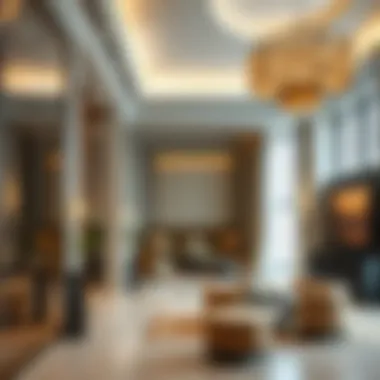
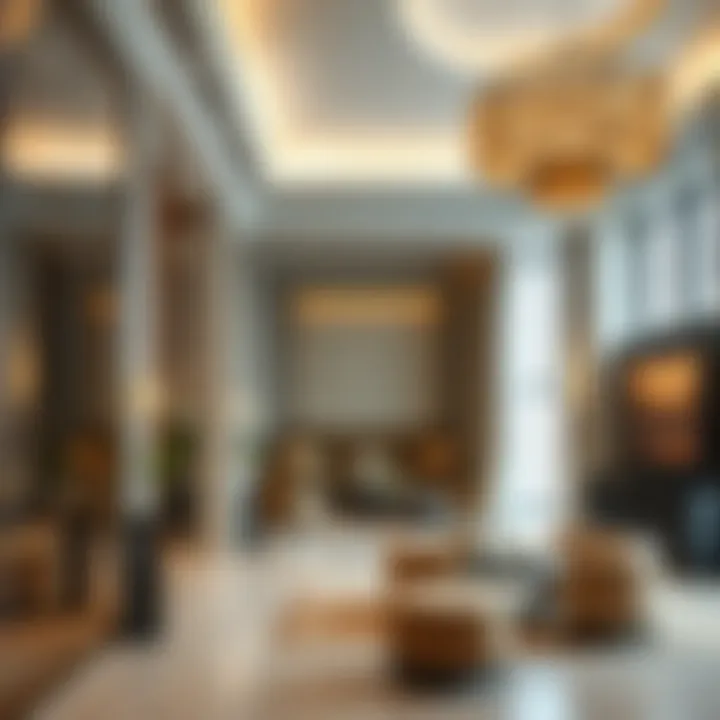
Inspirations Behind the Design
The inspiration behind the Al Suwaidi Building's design is multi-faceted, drawing from a rich tapestry of cultural, natural, and functional influences. One prominent source of inspiration is the UAE's profound relation to the desert landscape. The architect saw the contrasting elements of sand dunes and urban centers as a muse to create a building that flows organically within its environment.
Moreover, the rising skyline of Dubai itself played a crucial role in guiding the design ethos for the Al Suwaidi Building. Curves and angles mirror the nearby skyscrapers, while upholding a distinct identity that sets it apart. Such design choices cater to aspiring investors, homeowners, or anyone appreciating modern architecture's intricacies.
Other inspirations come from the Al Suwaidi family's heritage, deeply tied to Dubai's roots. Infusing cultural stories and familial values into the architecture enables the building to tell a story—one that reflects the city’s journey from humble beginnings to a pinnacle of luxury and progress.
To encapsulate, the vision behind the Al Suwaidi Building transcends mere construction; it's a holistic approach that combines cultural resonance with avant-garde architectural ideals. Through this building, the architect not only aimed to meet the demands of the present but also crafted a legacy that future generations can appreciate and admire.
Cultural Impact
The Al Suwaidi Building stands not just as a physical structure but as a resounding testament to the cultural evolution of Dubai. This significance arises from various dimensions, encompassing both the architectural symbolism and the engaging community interactions it fosters. Exploring these facets provides clarity on how this landmark transcends mere construction to become a pivotal element within the cultural tapestry of the city.
Symbolism in Architecture
Architecture often embodies the spirit of its time and place. The Al Suwaidi Building is no exception. It represents a blend of modernity and tradition, reflecting the aspirations of a city that embraces rapid growth while respecting its cultural roots. The design elements communicate a narrative of progress, where sleek lines symbolize innovation yet are interspersed with motifs that hint at Dubai’s rich heritage.
Saif Mohammed, a local architect, highlighted the building’s facade, stating,
"The intricate patterns etched into the surfaces are not just aesthetically pleasing; they tell stories of our past, guiding us towards our future."
In designing the Al Suwaidi Building, architects considered how to resonate with local sentiments, ensuring it reflects not only aesthetic value but also a sense of identity. Such symbolism plays a pivotal role in attracting attention from tourists and dignitaries alike, fostering a sense of pride among residents who see their culture represented on a global stage.
Community Engagement
The Al Suwaidi Building does not merely occupy space; it engages dynamically with the community around it. From hosting cultural events to community forums, the building serves as a nexus for local interactions. This engagement cultivates a sense of belonging, bridging gaps between diverse groups within Dubai’s multi-faceted society.
For instance, local art exhibitions held at the Al Suwaidi Building showcase the talents of emerging artists, allowing the public to experience art that speaks to their shared experiences. Engaging with the arts promotes dialogue among community members, enhancing cultural understanding and collaboration.
In addition to arts initiatives, the building organizes workshops for residents and expatriates. These events focus on sustainability, traditional crafts, and even contemporary lifestyle topics. The inclusive nature of these gatherings reinforces the idea that architecture can serve as more than just walls and roofs; it can be a facilitator of interaction and a promoter of cultural education.
Overall, the Al Suwaidi Building indeed exemplifies how architecture can embody cultural narratives and foster community spirit, making it more than a static landmark, but a vital player in the ongoing social dialogue within Dubai.
Market Trends Related to the Al Suwaidi Building
Understanding the market trends concerning the Al Suwaidi Building is crucial for both investors and homeowners. This section dives into the economic indicators and real estate dynamics that surround this architectural marvel, emphasizing the factors that make it an attractive investment opportunity. With its opulent design and strategic location, the Al Suwaidi Building is not just a physical structure but a beacon of potential growth in the Dubai real estate market.
Investment Potential
Rental Yields
Rental yields are a significant lure for real estate investors. For the Al Suwaidi Building, these yields are impressive, reflecting the high demand for residential spaces in this iconic locale. The key characteristic here is the strong rental market driven by both expatriates and locals. This demand creates a competitive edge for landlords, ensuring sustained returns on investment.
A unique feature of the rental yields in this area is the low vacancy rates. With numerous amenities nearby—such as luxury shopping, dining, and leisure activities—the Al Suwaidi Building presents an irresistible appeal. Therefore, for investors eyeing opportunities within Dubai, the potential for higher rental income stands out as a significant advantage. However, one must also consider the initial investment cost, which, while steep, reflects the building’s status and overall desirability in the luxury market.
Market Demand
Market demand is another critical facet of the investment landscape for the Al Suwaidi Building. The demand for properties in Dubai has continued to rise steadily, and this building is central to that narrative. One of the primary characteristics of the market demand here is the influx of overseas investors coupled with a solid base of local buyers. This mix fosters a robust real estate environment that can withstand economic fluctuations.
What sets the market demand for the Al Suwaidi Building apart is its diversified buyer interest. From affluent expatriates and business professionals to families seeking high-quality living spaces, the demand is multi-faceted. On the plus side, this diversity enhances stability; however, it might lead to varying expectations that sellers must navigate.
Comparative Analysis with Similar Properties
A comparative analysis with properties similar to the Al Suwaidi Building reveals its distinct advantages in the competitive Dubai market. Factors such as location, amenities, architecture, and pricing all play critical roles in understanding its positioning.
- Location: The Al Suwaidi Building enjoys an enviable spot, close to major business hubs and leisure districts, making it more sought-after than other buildings that might be farther from prime areas.
- Amenities: When stacked against similar properties, Al Suwaidi often comes out on top in terms of amenities. Luxurious swimming pools, fitness centers, and retail spaces can sway potential residents' decisions.
- Architecture: The exquisite design of the Al Suwaidi Building lends it a unique charm that many of its rivals lack, ensuring it stays top-of-mind for buyers and renters alike.
Legislative and Regulatory Considerations
The landscape of real estate in Dubai is not only shaped by architectural prowess and market dynamics but also heavily influenced by its legislative and regulatory framework. Understanding these legal parameters is crucial for investors, homeowners, and agents working with properties like the Al Suwaidi Building. Such considerations ensure that development aligns with city standards, promoting safety, sustainability, and overall community well-being.
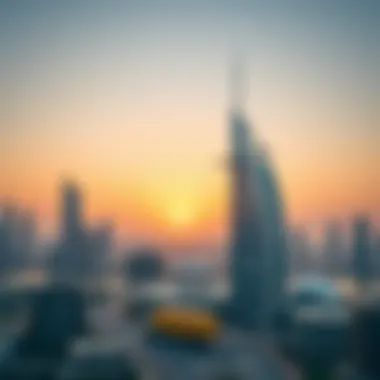
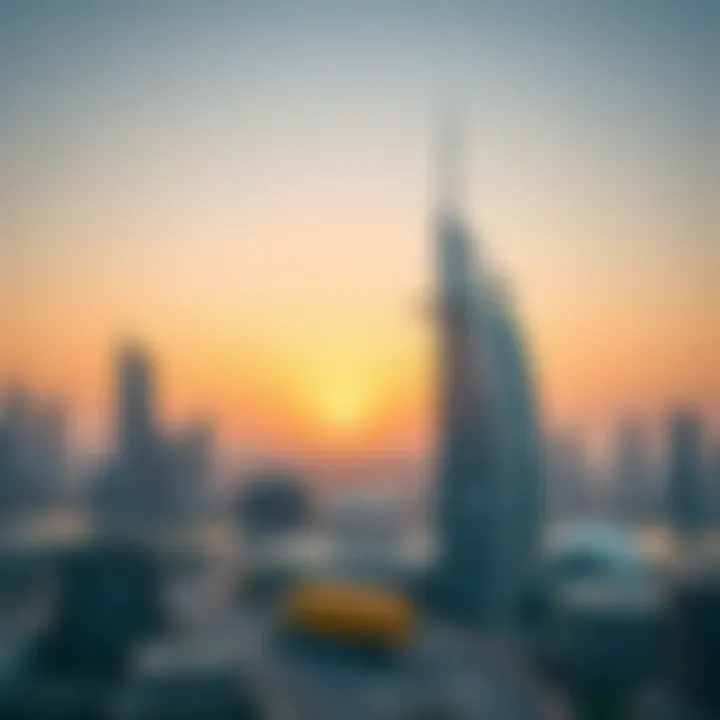
Building Codes and Standards
Building codes and standards are essential touchstones in the construction and operation of any modern edifice, and the Al Suwaidi Building is no exception. These regulations dictate how a building is constructed, ensuring that all safety protocols are strictly adhered to. For instance, the regulations in Dubai are incredibly detailed, covering aspects such as structural integrity, life safety systems, and fire prevention measures.
Here are some key points related to building codes and standards:
- Structural Integrity: Regulators ensure that buildings can withstand environmental factors like storms and earthquakes. This involves using specific materials and construction techniques.
- Fire Safety: Enhanced fire safety measures, including adequate exit paths, alarm systems, and sprinkler systems, are mandated. The Al Suwaidi Building, for example, integrates advanced fire-suppression technologies.
- Environmental Compliance: Adherence to local environmental standards ensures that the building is not only functional but also sustainable, reinforcing Dubai's commitment to environmental stewardship.
In essence, these codes are not mere bureaucratic hurdles; they elevate quality and instill confidence in buyers and tenants alike.
Real Estate Regulations in Dubai
Navigating the real estate landscape in Dubai requires familiarity with specific regulations that govern property transactions and ownership. Many expatriates and potential investors have a stake in understanding these regulations, which serve to protect both buyers and sellers in a competitive marketplace. The city's regulations support an environment where foreign investment thrives and property values remain robust.
Key aspects of real estate regulations include:
- Ownership Laws: Foreigners can own specific types of properties under certain conditions. The regulations clearly outline which areas are open to non-UAE citizens for freehold ownership. In this context, the Al Suwaidi Building, located in a sought-after area, aligns perfectly with these guidelines.
- Lease Terms: Clear regulations exist concerning lease agreements, defining tenant and landlord rights, which helps mitigate disputes. Investors can find assurance in knowing their legal rights when entering into contracts.
- Transparency in Transactions: Dubai’s real estate laws emphasize transparency, making it easier for buyers to verify property details. This is vital for maintaining the trust of all stakeholders in the property market.
"Clear real estate regulations in Dubai not only enhance buyer confidence but also attract international investors, fostering a stable market environment."
Overall, legislative and regulatory considerations act as a framework that guides the development and operation of noteworthy structures like the Al Suwaidi Building. By being aware of these standards, stakeholders can navigate the market more effectively, ensuring successful investments that contribute to Dubai's vibrant architectural landscape.
Future Prospects
The future of the Al Suwaidi Building is not just a matter of brick and mortar; it encompasses a broader vision tied to Dubai's aspirations for growth and development. As a central piece of the architectural puzzle, this building has the potential to mark new trends and set a benchmark for future real estate investments in the area. Understanding future prospects is critical for investors, homeowners, and stakeholders wanting to make informed decisions in a dynamic market landscape.
Development Plans Around the Area
In recent years, Dubai has put forth ambitious plans to further enhance urban development surrounding the Al Suwaidi Building. Key proposals include:
- Transportation Improvements: Infrastructure developments, particularly in transport, aim to reduce congestion and enhance accessibility. New metro lines and bus routes are being planned to connect this area more seamlessly with the rest of Dubai.
- Commercial Expansion: The establishment of shopping centers and entertainment venues nearby is expected to boost foot traffic. These commercial ventures can further increase property values and elevate the neighborhood’s profile.
- Green Spaces: Introduced plans for parks and community gardens will add a breath of fresh air to the dense urban environment. This commitment to greenery not only improves aesthetics but also promotes healthier living.
Understanding these development plans helps in gauging potential real estate value. With the right kind of investments funneling into the neighborhood, property prices are likely to increase, making now a prime time for potential investors to act.
Potential Resilience to Market Changes
The Al Suwaidi Building, due to its strategic positioning and the quality of its construction, is well-placed to endure market fluctuations. Several factors contribute to this relative resilience:
- High Demand Locations: Properties in sought-after locales historically exhibit a more stable demand. As Dubai continues to draw expatriates and investors alike, the Al Suwaidi Building will likely maintain its appeal.
- Diverse Tenant Base: With both residential and commercial spaces, the building can attract a wide range of tenants. This diversity serves as a buffer, helping mitigate risks during economic downturns.
- Brand Strength: The reputation of the building enhances its marketability. A well-regarded property can often weather financial storms better than lesser-known alternatives.
In times of uncertainty, a quality investment often rises above the fray, ensuring peace of mind for its owners.
Ultimately, the fusion of strategic development plans and the building's intrinsic market strengths positions the Al Suwaidi Building favorably for future growth. As opportunities unfold, it remains essential for stakeholders to keep an eye on the shifting tides in local real estate while seizing the possibilities that lie ahead.
Culmination
The conclusion serves as a pivotal part of any in-depth exploration, especially regarding an architectural marvel like the Al Suwaidi Building. Wrapping up the extensive discussion about this structure, it is crucial to reflect on its multifaceted contributions to both Dubai's skyline and its socio-economic landscape. The Al Suwaidi Building isn’t just a place that offers luxury living or commercial spaces; it stands as a testament to the interplay between modern design and cultural significance within the bustling city.
Summary of Key Points
To encapsulate what has been discussed:
- Historical Context: The Al Suwaidi Building, rooted in a rich narrative, mirrors Dubai’s rapid growth and cultural evolution.
- Architectural Distinction: Its distinctive features and innovative design techniques position it as a landmark in modern architecture.
- Market Relevance: The building plays a key role in the local real estate market, attracting investors, expats, and homeowners looking for high returns and luxurious living standards.
- Cultural Symbolism: Beyond its physical presence, the building resonates with the community, merging modernity with local heritage.
- Future Prospects: As development continues around the area, the Al Suwaidi Building is likely to maintain its relevance and adapt to changing market trends.
By examining these aspects, readers can appreciate the significance of the Al Suwaidi Building, not only as an architectural marvel but also as a key player in shaping Dubai’s identity.
The Al Suwaidi Building’s Legacy
The legacy of the Al Suwaidi Building is reflected in its lasting impact on both the architectural landscape and the surrounding community. It has become a landmark that symbolizes Dubai's ambition and innovation. This structure isn’t merely a collection of walls and windows; it represents a convergence of craftsmanship, culture, and commerce.
As time progresses, the memories and experiences created within its walls will cultivate a unique narrative of community engagement. It’s a gathering place, where people from diverse backgrounds converge, fostering a spirit of unity and collaboration. This building not only enhances the aesthetic appeal of Dubai but also strengthens the city's global standing as a hub for innovation and luxury.
To sum it up, the Al Suwaidi Building leaves behind a rich legacy that blends modern architecture with deep cultural significance. Its influence will likely echo through generations, aspiring to inspire future developments within the region.
"The Al Suwaidi Building stands tall as a beacon of modern architecture while firmly rooting itself in the cultural fabric of Dubai."
As potential investors and homeowners evaluate real estate opportunities in Dubai, understanding the profound legacy of the Al Suwaidi Building can provide invaluable insights. The building not only serves its immediate purpose but also contributes to the overarching narrative that shapes the city’s vibrant character.















